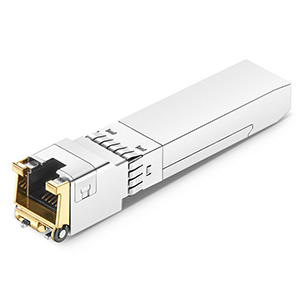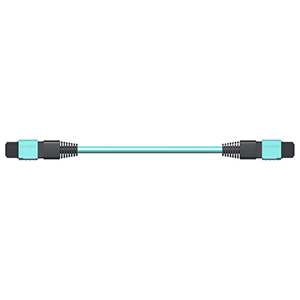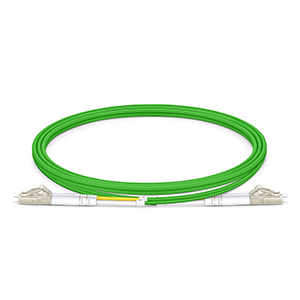SFP+ undoubtedly plays a key role in modern network equipment. This article will focus on the types of fiber optic cables required for SFP+. We will first define the physical structure and technical characteristics of SFP+ and explain its role in providing high-speed data transmission. Next, we will list the types of fiber optic cables commonly used for SFP+, such as multi-mode, single-mode, etc., and explain the technical parameters and applicable scenarios of each type of cable.
We will analyze the impact of factors such as transmission distance and bandwidth on cable selection, and consider factors such as physical compatibility and cost of cables. In addition, we will introduce the transmission characteristics and advantages of multi-mode fiber optic cables and explain the application cases in short-distance SFP+ networks. Finally, we will describe the transmission capacity and applicable scenarios of single-mode fiber optic cables and analyze their application value in long-distance SFP+ network deployment.

Overview of SFP+ Optical Modules
Let me introduce you to the basic concepts of SFP+ optical modules in detail.
SFP+ physical structure and technical features:
1. Physical structure:
- SFP+ is a small pluggable optical module interface standard.
- Its size is small, about half the size of a QSFP module.
- SFP+ modules can be directly inserted into network devices that support SFP+ interfaces, such as switches, routers, etc.
2. Technical features:
- SFP+ supports Ethernet transmission rates up to 10 Gbps and is the current mainstream high-speed optical module interface.
- Compared with early GBIC and SFP modules, SFP+ can provide higher bandwidth and transmission distance.
- SFP+ modules integrate multiple functional components such as optical transmission, optical reception, and signal processing.
The role of SFP+ in high-speed data transmission:
1. Support high-bandwidth applications:
- SFP+ can meet the bandwidth requirements of high-speed Ethernet and Fiber Channel such as 10 GbE and FC-10G.
- Provide reliable network support for applications that require large-capacity data transmission, such as high-definition video and cloud computing.
2. Improve transmission distance:
- SFP+ modules can achieve long-distance network interconnection through optical fiber transmission.
- Compared with copper cable transmission, optical fiber transmission is more resistant to interference and can cover a wider range of application scenarios.
3. Enhance network flexibility:
- SFP+ is a pluggable module that can be flexibly interchanged on different devices according to needs.
- This modular design improves the efficiency of network deployment and maintenance.
4. Optimize system power consumption:
- The SFP+ module has low power consumption, which is conducive to improving the energy efficiency of network equipment.
- This is of great significance in some power-sensitive application scenarios, such as data centers.
In short, SFP+ optical modules play a key role in high-speed Ethernet and fiber-optic networks with their high bandwidth, long-distance transmission, and flexible deployment, providing strong support for various data-intensive applications.
Types of fiber optic cables supported by SFP+ optical modules
Let me introduce you to the different types of fiber optic cables supported by SFP+ optical modules, as well as their technical parameters and applicable scenarios.
Common types of fiber optic cables for SFP+:
1. Multimode fiber (MMF):
- The core diameter is relatively large, generally 50μm or 62.5μm.
- Suitable for short-distance and medium-distance Ethernet transmission.
2. Single-mode fiber (SMF):
- The core diameter is relatively small, generally 9μm.
- Suitable for long-distance Ethernet and fiber optic communication transmission.
3. Multimode OM3/OM4 fiber:
- It is a high-performance multimode fiber with a core diameter of 50μm.
- It has higher bandwidth and transmission distance performance.
Technical parameters and applicable scenarios of various types of optical fiber cables:
1. Multimode fiber (MMF):
- The transmission distance is generally around 2-300 meters.
- The bandwidth is 100-1000 MHz·km, which can meet 1-10 GbE applications.
- It is suitable for medium and short distance scenarios such as campus networks and enterprise LANs.
2. Single-mode fiber (SMF):
- The transmission distance can reach 10-40 kilometers.
- The bandwidth is infinitely close, which can meet high-speed applications such as 10/40/100GbE.
- Suitable for wide area network, long-distance backbone transmission and other scenarios.
3. Multimode OM3/OM4 fiber:
- The transmission distance can reach 300-550 meters.
- The bandwidth is up to 2000-4700 MHz·km, supporting 10/40GbE transmission.
- Suitable for scenarios such as data centers and universities that require medium-distance high bandwidth.
In general, different types of fiber optic cables have different transmission distances and bandwidth performances. SFP+ optical modules can flexibly select matching fiber types according to actual application requirements. This flexibility is conducive to improving the cost-effectiveness and performance of the network.
Key factors for selecting SFP+ matching fiber optic cables
Let me analyze in detail the key factors that need to be considered when selecting SFP+ matching fiber optic cables.
The impact of transmission distance and bandwidth on cable selection:
1. Transmission distance:
- Choose the appropriate fiber optic transmission distance according to the actual needs of network deployment.
- Multimode fiber can be used for shorter distances, while single-mode fiber is required for long distances.
2. Transmission bandwidth:
- Choose fiber optic cables with corresponding performance according to the bandwidth requirements of network applications.
- If 10GbE applications require bandwidths up to 2000MHz·km, OM3/OM4 multimode optical fiber should be used.
3. Performance matching:
- The technical parameters of the optical fiber cable need to match the performance of the SFP+ module.
- Avoid the situation where the optical fiber bandwidth cannot meet the rate of the SFP+ module.
Physical compatibility and cost factors of optical fiber cables:
1. Physical compatibility:
- Ensure that the selected optical fiber cable is physically compatible with the optical interface of the SFP+ module.
- For example, single-mode optical fiber requires an LC interface, while multimode optical fiber commonly uses an SC interface.
2. Cost factors:
- Choose the appropriate fiber optic cable cost according to the budget and application scenarios.
- Generally speaking, the cost of multimode fiber is lower than that of single-mode fiber, but the transmission distance is limited.
3. Compatibility and cost trade-off:
- Try to choose a fiber optic cable with more cost advantages while meeting physical compatibility.
- However, if the network requirements cannot be met, performance indicators should be prioritized rather than cost.
In general, the selection of SFP+ supporting fiber optic cables requires comprehensive consideration of transmission distance, bandwidth, physical interface, cost and other factors to ensure the performance and economy of network applications.
Application of multimode fiber optic cable in SFP+
Let me introduce you to the application of multimode fiber optic cable in SFP+ network in detail.
Transmission characteristics and advantages of multimode fiber optic cable:
1. Transmission characteristics:
- The core diameter of multimode fiber is relatively large, usually 50μm or 62.5μm.
- Because light can propagate in multiple modes in a large core diameter, it is called “multimode” fiber.
2. Performance advantages:
- The optical signal transmission and reception of multimode fiber is relatively simple and the cost is low.
- In short-distance transmission, multimode fiber can provide sufficient bandwidth performance.
- For application scenarios with link lengths of 2-300 meters, multimode fiber can provide reliable transmission.
Application cases of multimode fiber in short-distance SFP+ networks:
1. Campus/enterprise LAN:
- In campus or enterprise internal networks, multimode fiber is generally used as the backbone transmission media.
- SFP+ modules can be used with multimode fiber cables to provide 10GbE-level high-speed interconnection.
- This can meet the needs of teachers, students or employees for high-bandwidth applications, such as video conferencing, data sharing, etc.
2. Data center interconnection:
- Inside the data center, the fiber interconnection between cabinets generally uses multimode OM3/OM4 fiber.
- SFP+ modules can be used with this type of high-performance multimode optical fiber to achieve 10/40GbE interconnection between racks.
- It improves the interconnection rate of devices within the data center and accelerates data transmission and processing.
3. Edge computing network:
- Edge computing devices are usually deployed closer to users and connected to the core network.
- In this application, SFP+ modules and multimode optical fiber cables can provide stable and reliable 10GbE transmission.
- It ensures high-speed interconnection between edge computing nodes and core networks and enhances network response speed.
In general, with its low cost and suitability for short-distance transmission, multimode optical fiber cables have broad application prospects in SFP+ networks, especially in scenarios such as campuses, enterprises and data centers.
Application of single-mode fiber cable in SFP+
Let me introduce you to the application of single-mode fiber cable in SFP+ network in detail.
Transmission capacity and applicable scenarios of single-mode fiber cable:
1. Transmission capacity:
- The core diameter of single-mode fiber is relatively small, generally 9 microns.
- Since it only supports a single light propagation mode, it is called “single-mode” fiber.
- Single-mode fiber has extremely high bandwidth and transmission distance performance, which can meet the application requirements of high-speed Ethernet.
2. Applicable scenarios:
- Single-mode fiber is very suitable for long-distance network transmission.
- Commonly used in cross-regional trunk network deployment such as wide area network and metropolitan area network.
- It plays an important role in application scenarios that require long-distance high-bandwidth transmission.
The application value of single-mode fiber in long-distance SFP+ network deployment:
1. Greatly improve the transmission distance:
- Single-mode fiber can achieve long-distance transmission of 10-40 kilometers.
- The transmission range of 2-300 meters far exceeds that of multi-mode fiber, meeting the application requirements of wide area networks.
2. Support high-speed Ethernet:
- Single-mode fiber can provide sufficient bandwidth performance and support high-speed Ethernet such as 10/40/100GbE.
- It is suitable for applications that require large-capacity data transmission, such as video surveillance, cloud computing, etc.
3. Improve network reliability:
- Single-mode optical fiber has strong anti-interference and better noise resistance during transmission.
- It helps to improve the stability and reliability of important networks such as wide area networks.
4. Reduce deployment costs:
- Compared with copper cables, single-mode optical fiber has lower laying and maintenance costs.
- In applications that require long-distance network interconnection, it can bring greater economic benefits to users.
In short, single-mode optical fiberFiber optic cables play an indispensable role in SFP+ networks and can provide solid technical support for cross-regional high-speed Ethernet transmission. It is an ideal choice for building important network infrastructure such as wide area networks and metropolitan area networks.
Summary
Rational selection of fiber optic cables for SFP+ is crucial to building high-performance networks. Our company has long focused on the research and development and production of network equipment and its supporting products, and has rich industry experience. Our fiber optic cable products have reached the industry-leading level in optical parameters and reliability, and can meet your demanding needs for SFP+ networks.
Whether you need to deploy in a data center, metropolitan area network, or industrial site, we can provide you with customized SFP+ fiber optic cable solutions. At the same time, our professional team will provide you with a full range of technical support, including solution design, on-site guidance, and daily maintenance suggestions. Contact us now to learn more about SFP+ fiber optic cables.
SFP+ FAQ
SFP+ is a type of hot-pluggable, compact, and high-speed optical or copper transceiver used in Ethernet, Fibre Channel, and other networking applications.
SFP+ transceivers typically use single-mode fiber optic cables, such as G.652 or G.657 standard fibers, for longer-reach applications.
Yes, multimode fiber optic cables can be used with SFP+ transceivers, but the maximum reach is generally shorter than when using single-mode fiber.
The maximum reach can vary from 10 km to 80 km or more, depending on the specific SFP+ transceiver type and the fiber optic cable characteristics.
You should consult the specifications provided by the SFP+ transceiver manufacturer to ensure compatibility with the fiber optic cable type and reach requirements.
Important factors include the fiber type (single-mode or multimode), core/cladding diameter, wavelength, and attenuation characteristics.
Yes, you can use standard fiber optic patch cables, but the cable length and specifications should match the requirements of the SFP+ transceiver.
Careful handling, cleaning, and insertion of the fiber optic cables into the SFP+ ports are essential for reliable operation.
Potential issues include fiber mismatch, excessive attenuation, and compatibility problems between the cable and transceiver specifications.
Advancements include the introduction of higher-density fiber optic cabling solutions, bend-insensitive fibers, and the use of newer fiber types like G.657.
SFP+ Related Products
-
25G SFP28 1310nm 10km LC Optical Transceiver Module
-
25G SFP28 1310nm 30km LC Optical Transceiver Module
-
25G SFP28 850nm 100m LC Optical Transceiver Module
-
25G SFP28 850nm 300m LC Optical Transceiver Module
-
25G SFP8 1300nm 80km LC Optical Transceiver Module
-
25G SFP8 1310nm 40km LC Optical Transceiver Module




